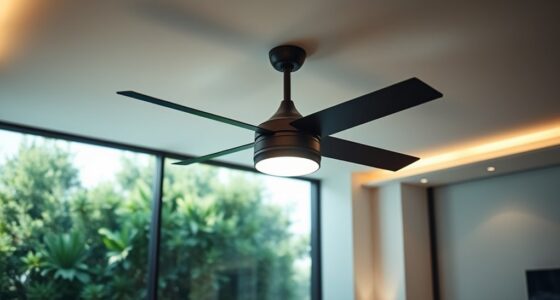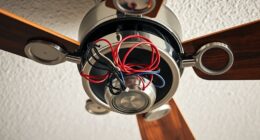Energy Star ratings for ceiling fans measure their energy efficiency using the airflow efficiency metric (CFM/W), which indicates how effectively a fan moves air relative to its energy consumption. Higher ratings mean better performance and lower operating costs, with rigorous testing by the EPA ensuring accurate comparisons. Understanding these ratings helps you select models that balance airflow, noise levels, and energy savings. Exploring these metrics further can enhance your ability to choose ideal, eco-friendly fans for your needs.
Key Takeaways
- Energy Star ratings measure ceiling fans’ energy efficiency, primarily based on airflow per watt (CFM/W).
- Fans must pass EPA testing standards, including airflow efficiency, noise, and overall performance, to earn certification.
- Higher CFM/W ratings indicate better airflow with less energy consumption, promoting cost savings.
- Certification helps consumers identify reliable, energy-efficient fans and may qualify them for rebates or incentives.
- Ratings enable comparison of models to select fans that optimize airflow, reduce utility costs, and support environmental sustainability.

Understanding Energy Star ratings for ceiling fans is essential for making energy-efficient choices that can reduce utility costs and environmental impact. These ratings serve as a standardized metric, enabling consumers to compare fans based on their energy consumption, performance, and efficiency. The core of this system is the rigorous testing protocol established by the Environmental Protection Agency (EPA), which evaluates a fan’s energy use relative to its airflow, noise level, and overall efficiency. When selecting a ceiling fan, you should focus on the fan’s airflow efficiency, measured in cubic feet per minute per watt (CFM/W). Higher values indicate that the fan can move more air using less energy, which translates directly into lower electricity bills and reduced carbon footprint.
Energy Star ratings help identify efficient ceiling fans that save energy and reduce costs.
The Energy Star certification process involves testing fans under controlled conditions that simulate typical operation. Fans must meet specific criteria for airflow efficiency, which vary depending on size and design, ensuring that only models with *ideal* performance earn the label. This involves analyzing not just the fan motor’s power draw but also the blade design and aerodynamics, as these influence how effectively the fan circulates air. A fan with a high airflow efficiency rating consumes less electricity for the same cooling or circulating effect, making it a more sustainable choice over time. The certification also considers noise levels, as quieter operation is often associated with better engineering and motor efficiency.
In addition to technical specifications, the Energy Star label acts as a safeguard against subpar products that may claim energy savings without delivering on those promises. It requires manufacturers to meet ongoing performance standards, which evolve to incorporate technological advancements and tighter efficiency benchmarks. As a consumer, you can leverage this information to identify models that deliver consistent performance while minimizing energy waste. *Furthermore*, selecting an Energy Star-rated ceiling fan can qualify you for incentives or rebates offered by utility providers or government programs, further reducing your upfront investment.
Understanding how these ratings are calculated helps you interpret product descriptions more critically. For example, a fan with a high CFM/W ratio indicates superior efficiency, meaning it moves more air for less power. Conversely, fans with lower ratings may consume more energy without offering proportional airflow, leading to higher long-term costs. By analyzing these metrics and considering your specific room size and needs, you *guarantee* that your purchase aligns with both your comfort and sustainability goals. Additionally, awareness of regional divorce statistics can help you understand broader societal trends that influence household decisions and resource allocations. Overall, Energy Star ratings provide a technical, reliable framework that guides you toward ceiling fans that *maximize* energy use, cost savings, and environmental responsibility.
Frequently Asked Questions
How Often Are Energy Star Ratings Updated for Ceiling Fans?
Energy Star ratings for ceiling fans are typically updated annually, reflecting the latest product data and efficiency standards. You should monitor the official Energy Star website or certification bodies for the most recent updates. This periodic review guarantees that the ratings accurately represent current technology and energy-saving performance. Staying informed allows you to make data-driven decisions when selecting ceiling fans that meet energy efficiency criteria.
Do Energy Star Rated Fans Cost More Upfront Than Non-Rated Fans?
Energy Star rated fans typically cost more upfront due to advanced efficiency features and quality components, but the savings in energy costs often outweigh this initial investment. While the price difference might seem significant, the long-term reduction in electricity bills can compensate for the higher purchase price. As a result, investing in an Energy Star fan is a cost-effective choice, especially if you prioritize energy efficiency and long-term savings.
Can Energy Star Fans Be Installed Outdoors Safely?
Yes, Energy Star fans can be installed outdoors safely if they are specifically rated for outdoor use. These fans feature corrosion-resistant materials and weatherproof motor housings to withstand moisture, UV rays, and temperature fluctuations. Always verify the product specifications to confirm outdoor suitability. Proper installation in a covered, protected location enhances safety and longevity, preventing damage and electrical hazards associated with exposure to the elements.
How Do Energy Star Ratings Impact Long-Term Energy Savings?
Energy Star ratings substantially influence your long-term savings, as certified fans use up to 20% less energy than non-rated models. This reduction directly decreases your monthly energy bills and extends your appliance lifespan. By choosing Energy Star-certified fans, you optimize efficiency, lower operational costs, and contribute to environmental sustainability. Over time, these savings accumulate, making the initial investment worthwhile and delivering measurable financial benefits.
Are There Specific Brands Known for High-Rated Energy Star Ceiling Fans?
Yes, brands like Hunter, Emerson, and Minka-Aire are recognized for producing high-rated Energy Star ceiling fans. These manufacturers prioritize energy efficiency through advanced motor design, optimized blade pitch, and smart control features. When selecting a fan, examine the Energy Star label to verify it meets strict efficiency standards. Investing in these brands can considerably reduce energy consumption and operational costs over time, aligning with your long-term savings goals.
Conclusion
By understanding Energy Star ratings, you can make informed decisions that optimize efficiency and reduce energy costs. These ratings serve as a reliable compass, guiding you through the technical landscape of ceiling fan performance. Prioritizing Energy Star-certified fans ensures you’ll reap the benefits of advanced technology, translating to tangible savings. Fundamentally, embracing these ratings is like installing a smart, energy-efficient engine—driving your household toward sustainability with precision and confidence.









